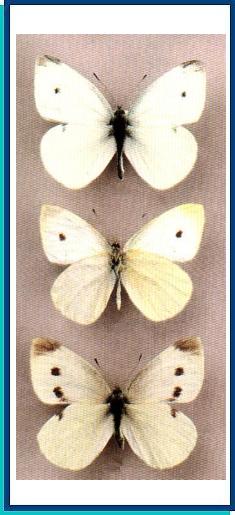LEPIDOPTERA
PIERIDAE Duponchel,1835
PIERIS Schrank,1801
Pieris rapae (Linnaeus, 1758)
Pieris rapae rapae (Linnaeus, 1758)

• TYPE LOCALITY. Sweden.
• RANGE. The entire Palaearctic Region with the exception of the extreme north and south.
• DISTRIBUTION AND VARIATION. The nominate subspecies is distributed over the central European part and Siberia. In addition, the following subspecies can be recognized: ssp. deleta (Strand, 1901) (= flavida Petersen, 1902) - the N. European part; ssp. transcaucasica (Stauder, 1925) - the Caucasus Major and Minor, the Armenian Highland; ssp. meleager (Hemming, 1934) (= iranica LeCerf, 1914, nom. praeoccup.) - Talysh, Kopet-Dagh; ssp. kenteana Ruhl, [1893] (= viluiensis Rober, [1907]) - the Altai and Sayan mts., Transbaikalia, the Far East, Kamchatka; ssp. crucivora (Boisduval, 1836) (= orientalis Oberthur, 1880; = mandschurica Speyer, 1882; = wladiwostokensis Kardakov, 1928) - the Amur and Ussuri regions, Sakhalin; ssp. debilis (Alpheraky, 1889) (= eumorpha Fruhstorfer, 1911; = pulverea Verity, 1911; == accrescens Stauder, 1924) - the SE. European part, Turan, Tian-Shan, Ghissar, S. Ghissar, Darvaz, Alai, the Pamirs.
• HABITATS AND BIOLOGY. A common species on cultivated lands. Flight period: April-October in a succession of two to four generations. Commonly damages field and vegetable crops: Brassica spp., Sinapis, Raphanus sativus, etc. (Brassicaceae). Pupa hibernating.
• SIMILAR SPECIES. P. ergane: black pattern on UP reduced, black spot on UNF in cells M3-Cul absent. P. canidia: wingsmore stronglyproduced; UNHwith intensive greyish dusting.
Photo and text: Guide to the BUTTERFLIES OF RUSSIA and adjacent territories Volume 1. PENSOFT, Sofia - Moscow. 1997